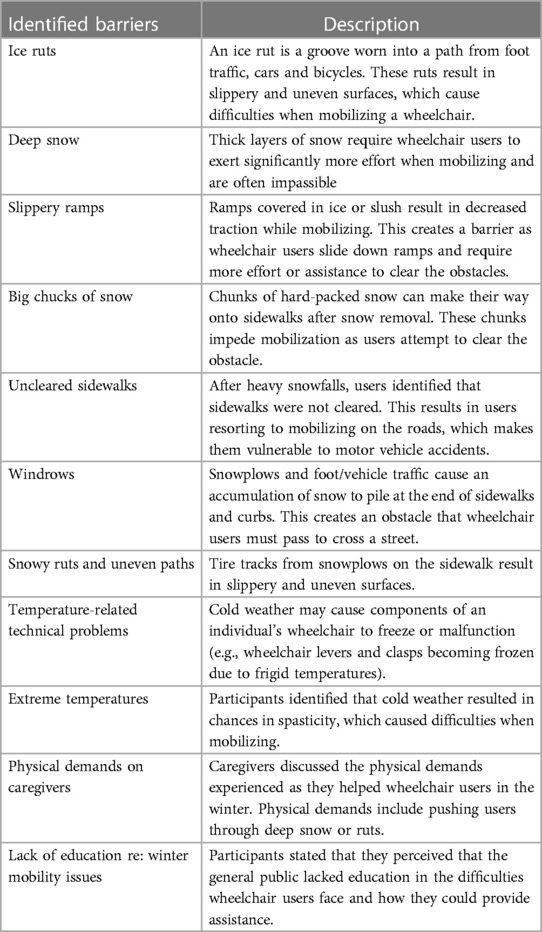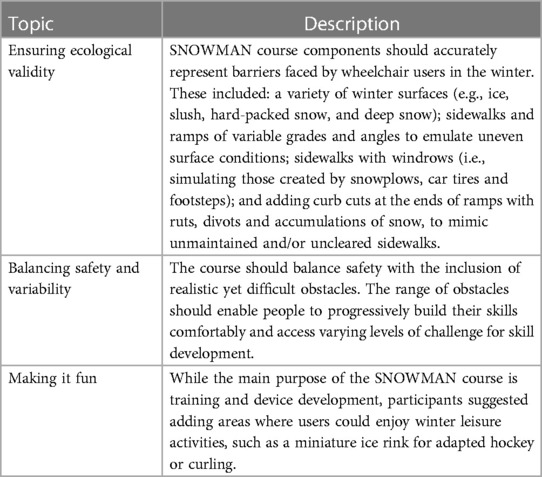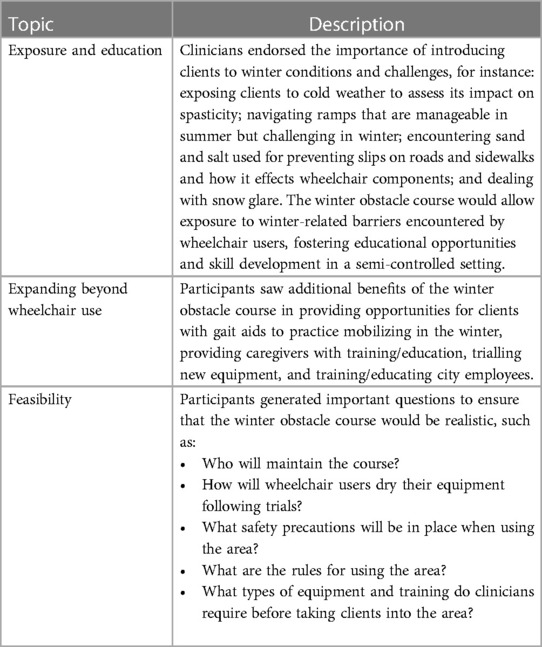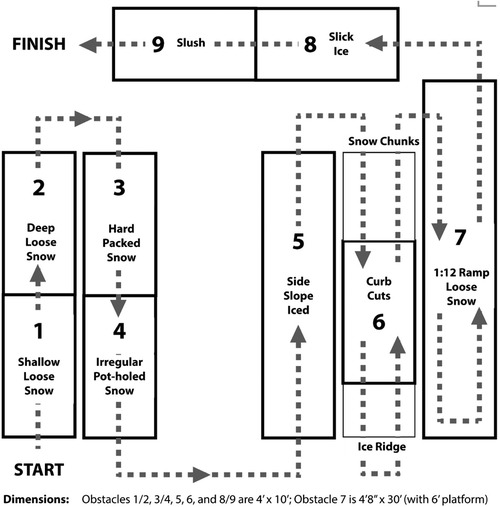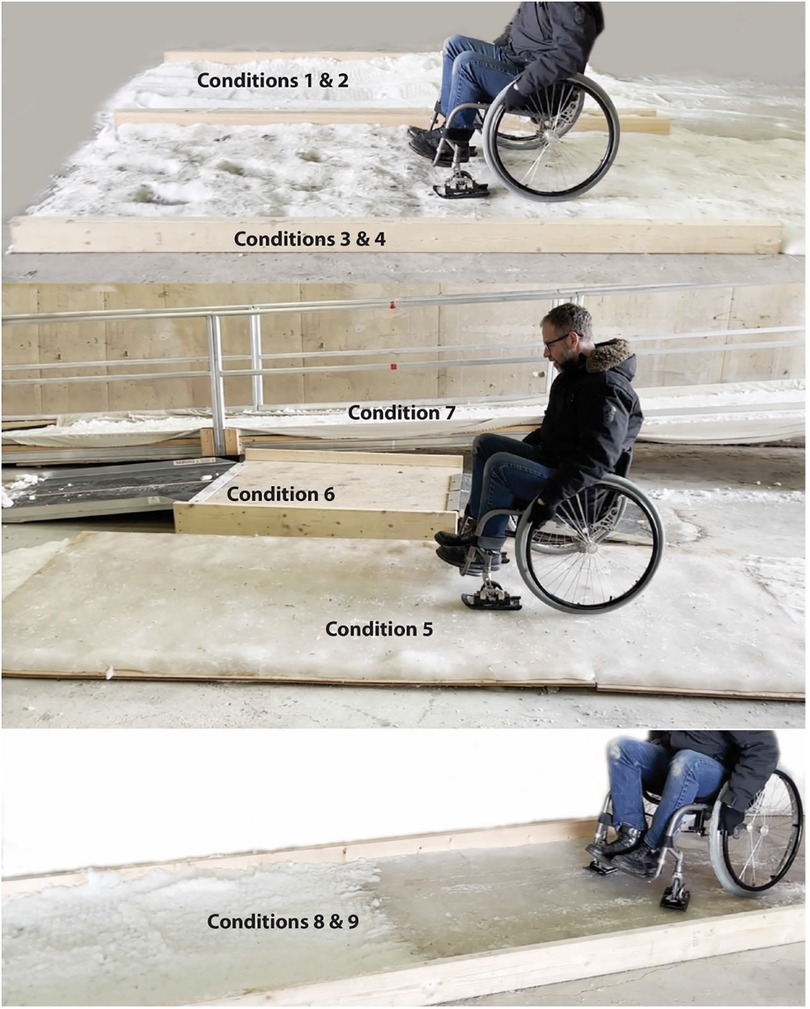Development of the Standardized Navigation Of Winter Mobility & Accessibility Network (SNOWMAN) course
- 1Department of Occupational Therapy, College of Rehabilitation Sciences, University of Manitoba, Winnipeg, MB, Canada
- 2Rehabilitation Engineering and Design Laboratory, MAKE+ Applied Research, British Columbia Institute of Technology, Burnaby, BC, Canada
- 3School of Rehabilitation Sciences, Faculty of Medicine, Université Laval, Quebec City, QC, Canada
- 4Applied Health Sciences, University of Manitoba, Winnipeg, MB, Canada
Introduction: Manual wheelchairs (MWC) users have limited mobility during winter months as they encounter many environmental barriers that restrict their community participation. This paper outlines the creation and standardization of an outdoor environment designed to simulate the real-life conditions and obstacles experienced by MWC users in winter.
Methods and results: This study consisted of four phases. In Phase 1, researchers used a qualitative ethnographic approach to document the specific challenges and adaptive strategies used by MWC users in winter conditions. In Phase 2, key informants with expertise in MWC winter mobility were invited to co-design the Standardized Navigation Of Winter Mobility & Accessibility Network (SNOWMAN) course. Participants reviewed draft design solutions and offered their input and suggestions to expand upon the initial design. A second co-design workshop included additional key informants, including service providers, policymakers, and professionals with expertise in landscape architecture and engineering, to validate the design solution. The workshops resulted in a detailed illustration of the SNOWMAN course, including five sections: platforms with side slopes, a miniature ice rink, curbs and curb cuts, a path with uneven winter surfaces, and modular ramps at various slopes. Phases 3 and 4 marked the conclusion of the study and involved fabrication of the SNOWMAN course and establishment of a standardized protocol for course setup and maintenance.
Discussion: The project aimed to offer several additional potential benefits, supported by the various stakeholders across the study phases, that extend beyond creation of a controlled and safe environment for wheelchair users to develop their winter mobility skills. Practicing wheelchair skills in this area may assist wheelchair users in gaining confidence which may ultimately translate to increased participation in the community.
1 Introduction
Individuals who use manual wheelchairs (MWC) as their primary means of mobility typically experience seasonal-related accessibility barriers in the winter months (1). Environmental barriers such as icy or snow-covered surfaces and snow windrows have been reported as frequent barriers to mobility in studies of MWC users in Manitoba (2, 3). During the winter season, individuals often decrease their outdoor activities and community engagement; however, MWC users face unique obstacles that are not experienced by individuals without disabilities, which further impede their ability to go out during the winter months (4, 5). These seasonal barriers can influence both the frequency and quality of community participation. Findings from a 12-month longitudinal study of 11 wheelchair users confirmed they made fewer trips per day and wheeled shorter distances at slower speeds during non-summer (vs. summer) months, on winter days with (vs. without) snow accumulation, and on winter days when temperatures were below (vs. above) 0°C (1). A focus group with eight Manitobans who use wheelchairs concluded that winter community participation should be considered a right for all citizens (6). Taken together, this body of research provides evidence that inclement winter-related barriers have detrimental effects on community participation among individuals who use an MWC.
According to available data, there is an estimated 288,800 individuals in Canada who use a wheelchair or scooter for community mobility. Among these users, nearly 70% have a MWC, while approximately 15% own a power wheelchair (7). Given the high prevalence of use and more adverse impact of weather conditions and terrain, the effects of winter on MWC users is particularly relevant for investigation. Observations and recounting by MWC users have identified a variety of factors that contribute to the challenges of using a MWC in winter conditions. Ice or hard-packed snow on travel surfaces causes traction loss and slippage for both the larger rear drive wheels and the smaller front casters (1, 6, 8, 9). This loss of traction can impede forward movement or create an undesired direction change due to asynchronous wheel rotation (1). The presence of cross slopes (e.g., wheeling on a sidewalk or across a driveway) can cause the MWC to slide sideways due to gravity and reduced traction (10). These conditions require additional energy expenditure and increase the risk of collisions and tipping sideways (10). Deeper snow or snow windrows cause the small front casters to sink into the travel surface, preventing forward movement. Pushing to overcome this resistance risks tipping the MWC backward, especially when ascending or descending ramps, as maneuvering a wheelchair with raised casters (e.g., in a wheelie) makes it more susceptible to tipping (6, 8, 9). Gravity creates additional resistance when travelling on inclines and generates undesirable momentum when travelling down a slippery slope (10). Snow or slush accumulation at the lower end of the ramp (when ascending) or at the ground/ramp transition (when descending) impedes caster roll, causing sudden stop and tipping hazards (10). Unaddressed snow accumulation on level ground creates ruts that become vertical barriers to an MWC user who wants to change course (10). The user must traverse the outer margins of the ruts, which is particularly difficult with small casters, and may slide back into the rut or tip over backwards when attempting to elevate casters up and out of the rut margins (10). In summary, winter conditions reduce MWC control due to slippage, increased effort due to rolling resistance, and pose stability and safety issues.
Recommendations to enhance winter mobility for wheelchair users have focused on technology improvement (3, 5), and a few studies have delved into effective strategies and devices. Recent studies have attempted to make improvements in MWC users' experience by collating information on wheelchair mobility strategies (11) and developing protocols to make area more accessible for MWC users (12). Some research has examined experienced users navigating snow-covered ramps (8) and inexperienced users using various caster types on snow and inclines (9). However, there is a significant gap in knowledge regarding winter mobility. A scoping review by the authors found only 23 studies on winter mobility involving various mobility devices (13). A few studies of winter mobility have been conducted in simulated or controlled experimental environments (14), which lack the real-world challenges of genuine winter conditions. While useful in advancing this area of research, these settings lack the ecological validity and dynamic weather and environmental challenges of authentic winter conditions.
Currently, there is an absence of ecologically valid areas for wheelchair users to develop skills to overcome challenges faced in the winter. To address this research gap, we undertook the development of a Standardized Navigation Of Winter Mobility & Accessibility Network (SNOWMAN) course. This outdoor, winter-specific environment would incorporate a comprehensive set of conditions and obstacles/barriers commonly encountered. The intended application of the SNOWMAN course would be the development and evaluation of new devices and techniques as well as clinical interventions such as assessment and training with new and experienced mobility device users to navigate winter challenges in a safe and semi-protected, but ecologically valid, context. The purpose of this project was to conceptualize, create, and standardize use of SNOWMAN course.
2 Study design and team
This study employed four phases. Phase 1 documented and compiled specific real-world challenges MWC users encounter in the community and the adaptive strategies they employ for navigating winter conditions, using qualitative and observational data obtained via a go-along interview approach. Phase 2 used a Codesign Framework with key informants to identify and prioritize which real-world winter conditions were essential to the SNOWMAN course and then integrated them into a prototype design. In Phase 3, a prototype SNOWMAN course was fabricated. Phase 4 developed a study protocol, including the measurement of ambient weather conditions to standardize administration in subsequent studies, setup of course components, and measurement of component attributes. These phases are addressed sequentially below. The interdisciplinary research team consisted of researchers with backgrounds in occupational therapy, architecture, rehabilitation engineering, and wheelchair design and use.
3 Methods and findings
3.1 Phase 1: MWC user experiences with winter conditions
To identify the specific challenges and explore strategies that MWC users employ to negotiate winter conditions in the community, a qualitative ethnographic or “firsthand” research method was used (15). Ethnographic methods allow researchers to act as participant-observers (15). Using a “go-along” methodology (16) researchers were able to observe and verbally engage with MWC users to capture winter wheeling experiences in an authentic, natural setting.
Four community-dwelling individuals with spinal cord injury (SCI) participated. All participants were 18 years of age or older, had used an MWC for at least two years, and were in stable health (e.g., no known cardiac conditions). Participants were recruited through an outpatient SCI clinic and a provincial SCI advocacy organization.
Each participant's MWC was instrumented with a user point-of-view GoProTM video capture device and accompanied by a research assistant. and were asked to wheel their MWC through their own immediate community for up to 30 min. Two research assistants accompanied each participant: one as a spotter to ensure safety and the other for data collection (i.e., operating a second video camera for contextual perspective and audio recording of their experiences with the winter challenges and obstacles). In situ, participants were asked to point out challenges or obstacles they encountered and then demonstrate any strategies used to address these challenges. Immediately following the go-along activity, participants were taken to an indoor environment to engage in a 60-min audio-recorded debrief session with the research assistants. The go-along video footage was shared in an episodic fashion, stopping at specific events, and asking the participant to provide a narrative of what had occurred by highlighting and describing the challenges and strategies used to navigate the community.
The audio and video recordings from the go-along and debrief activities were not transcribed verbatim but viewed and listened to several times by the researchers to facilitate data analysis. Using NVivo 10.0 qualitative analysis software to manage and link the video and audio recorded data, the challenges and strategies identified in the video recordings and later discussed in the audio recordings were coded and categorized by the investigators. Integrative analyses of participants’ data resulted in the development of a table of challenge types and conditions. Data analysis proceeded in an inductive manner, with each subsequent participant's data entered into the table as it was collected. The validity and comprehensiveness of the final compilation of documented barriers and strategies were confirmed by a research team member not involved in data collection, who is an experienced MWC user. Barriers and challenges identified included ascending and descending snow and ice-covered slopes and curb cuts; traversing shallow, deep and slushy snow; navigating ruts and windrows; and traversing irregular snow-packed surfaces. This list and the video footage (for illustration purposes) were fed forward into Phase 2 to inform the co-design sessions.
3.2 Phase 2: co-design of the SNOWMAN course
To identify which specific components/obstacles were essential to include in the course, key informants with expertise in MWC winter mobility were invited to attend one of two half-day co-design sessions. Co-design refers to the act of collective creativity shared by two or more people, where the MWC user is an “expert in [their] own experience” (17). Co-design has been successfully used as a means to enhance understanding of how winter conditions affect wheelchair mobility in order to develop appropriate design solutions (18). As a guiding principle that everyone has a high creative potential and ideas on how to improve their situation, we sought diverse points of view regarding a common experience. We used an established four-step co-design framework (19), addressing the first three steps (conception of the design solution; validation of the design solution, and development of the course configuration) during two half-day workshops with key informants. The fourth step (testing of the course components) was addressed in Phase 3 of this study.
For conception of the design solution, key informants included a group of five wheelchair users and three caregivers. Each wheelchair user was at least 18 years of age, had used a wheelchair for at least two years, and had experience going out into the community with their wheelchair during winter months. Key informants were first presented with a sketched draft of possible design solutions previously developed by the research team through collaborative discussions, existing literature, and Phase 1 results. The draft design was configured for an existing sheltered outdoor space at the proposed site (a rehabilitation hospital). The draft course sketches consisted of modular sidewalk ramps (some of which were horizontal, sloped, or canted sideways) which could be integrated to create winter mobility obstacles. Each ramp consisted of a different winter condition through which wheelchair users would navigate (i.e., ice, water, deep snow, ruts, and slush).
The research team explained the project intent, and participants were invited to write, draw, or design changes on print versions of the draft design. Next, participants verbally described their ideas, with the co-design lead illustrating these in real-time. This was particularly important because once all participants understood the drawings, a common language was established, allowing everyone to contribute. The research team contributed input to concretize, give form, and translate the ideas into various design proposals. All proposed ideas were discussed collectively until a consensus proposal was achieved. By the end of the session, participants had comprehensively identified winter barriers faced by wheelchair users (see Table 1 for a list and description of barriers) and discussed how the initial draft design might be further enhanced (See Table 2 for a list of discussion topics and descriptions.).
The consensus proposal was consolidated by the co-design lead into a more refined graphic depiction (See Figure 1 for a detailed illustration of the results). The course included five sections: (1) platforms with side slopes similar to what wheelchair users encounter propelling on the sidewalk) and covered with a variety of conditions, including hard-packed snow, ice and slush; (2) a miniature ice rink where users can practice mobilizing on icy surfaces; (3) curbs and curb cuts that each feature a different winter condition as well as windrows piled at the bottom of the entrance to mimic unmaintained/uncleared sidewalks; (4) a path of uneven winter surfaces that wheelchair users typically encounter in the community such as ice ruts, deep snow, and large chunks of snow, and (5) modular ramps at various slopes with different winter conditions.
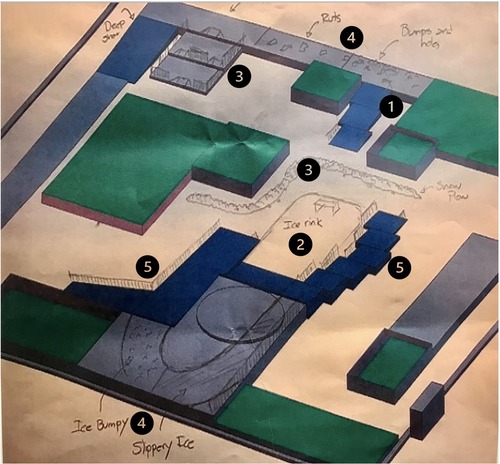
Figure 1. Initial consensus design proposal. Numbers align with section descriptions provided in manuscript text.
For validation of the design solution and development of course configuration, a second co-design workshop was conducted with six additional key informants (i.e., service providers, policymakers, and professionals with expertise in landscape architecture and engineering). The refined consensus design from session one was presented for criticism, enrichment, and confirmation, with the goal of enhancing the design and setting parameters that would result in a realistic, practical, and feasible solution (See Table 3 for details of discussion topics). They expressed enthusiasm for the concept and identified additional uses for such a course but also proposed some feasibility concerns regarding setup, maintenance, and safety. For instance, they advocated reducing the proposed grade of slopes to be within accessibility guidelines rather than the steep “ski slope” that had been proposed by the first group. They identified the need to add rails to higher platforms to prevent accidental falls and the need to create barriers to areas that might be hazardous if individuals were able to use the course without support or supervision. Based on the proposed conceptual design in session one and subsequent support and refinement provided in session two, we felt confident in our stakeholders' validation of the SNOWMAN course. The validated results from the second co-design session were defined using Solidworks 3D design software (Dassault Systems, Waltham, MA), producing specifications for the construction of the course components (not shown).
3.3 Phase 3: fabrication of the SNOWMAN course
Due to cost, space, and resource constraints, a reduced-scope prototype of the SNOWMAN course was fabricated in winter 2022–2023. We constructed the standardized course in a large uninsulated covered shed which was unheated and fully exposed on one wall. The course was created in Winnipeg, Manitoba, Canada, where the average winter temperature between November–March is −10.7°C and the average snowfall is 20.9 mm. The course included a defined pathway, taking wheelchair users through a series of nine challenging winter conditions: (1) shallow (2”) loose snow, (2) deep (4”) loose snow, (3) hard-packed snow, (4) irregular pot-holed snow, (5) iced 5° side slope/sidewalk, (6) two curb cuts with snow chunks and an ice ridge at the two approaches, (7) a 1 : 12 (5°) snow-covered ramp (1/2” snow) with snow accumulation at the base, (8) a slick icy flat surface, and (9) a slushy surface. See Figure 2 for a schematic of the course and Figure 3 for a series of photos of the course in January 2023.
3.4 Phase 4: development of a protocol for standardization of course setup and measurement of component attributes and ambient weather conditions
As there was no literature available regarding the creation of winter conditions, our research team undertook a process of fabricating snow and ice compositions required for each course component. This process was necessarily iterative to achieve conditions that would mimic real-world winter obstacles. Once these were satisfactory, we created a protocol manual to ensure consistent replication. Because the course is situated outdoors, we were unable to control for ambient temperature and humidity; however, most conditions of the course were under investigator control and made as consistent as possible for future testing, training, or evaluation sessions. For instance, water was sprinkled on the icy surfaces with a watering can prior to testing to ensure a comparable coefficient of friction. Loose snow was added to the shallow and deep snow obstacles to ensure correct depth when this had been reduced due to sublimation and were subsequently groomed using a bow rake. Slushy snow was prepared by mixing windshield washer fluid (containing anti-freeze) and soft snow in specific proportions to ensure homogenous and consistent hardness and density. New snow was added to the ramp and groomed for each trial as snow left in place tended to get hard and freeze to the ramp. Additionally, the snow chucks were replaced at the bottom of the curb cuts whenever these were disturbed during use.
Given the specified obstacle composition and the course location outdoors, we also developed a standardized protocol for testing the controllable obstacle snow conditions as well as the uncontrollable weather conditions so these could be documented in a consistent way. Using valid and reliable methods identified in the literature (19), we developed a standardized protocol (available upon request from the first author) for measuring the constructed obstacle snow conditions as well as the ambient weather conditions. This protocol was completed by a research assistant (RA), who was hired to set up, maintain, and groom the course components and to document conditions in preparation for subsequent data collection. The standardized protocol involved measuring and recording ambient temperature and humidity; snow depth, surface temperature, hardness, and density on snow-covered obstacles; and coefficient of friction on icy surfaces.
4 Discussion
Based on expert stakeholders' lived experiences with winter conditions, we successfully created a standardized outdoor wheelchair mobility course consisting of nine unique winter obstacles and a course construction and maintenance protocol. Following the co-design sessions, it was clear that wheelchair users, caregivers, clinicians, professionals, and policymakers were supportive of project SNOWMAN.
Through the project, we identified the need to develop a space that incorporated multiple and varied winter conditions routinely encountered to enable comprehensive comparison and evaluation that could differentiate between different mobility devices and solutions. Furthermore, we identified the need to create a context that was of sufficient space to replicate real-life challenges (i.e., enough of the obstacle to capture authentic encounters and to replicate the authenticity of overground propulsion). Although standardization of conditions in such an outdoor course may not mirror precisely reproducible indoor laboratory environments, a strength of this winter test course is its applicability to varying, real-world conditions that are not captured in an ecologically valid way by traditional research settings.
The development of the SNOWMAN course provides an opportunity to address the evaluation of wheelchair mobility skills in diverse contexts. Existing outcome measures, such as the Wheelchair Skills Test (19, 20) are comprehensive in scope of mobility skills included but may not address the same breadth of environments and surfaces, particularly in standardized testing. SNOWMAN may provide the opportunity to use such outcome measures in a complementary way or potential adaptation of existing measures for evaluation in winter environments.
The project aims to offer several additional potential benefits, supported by the various stakeholders across the study phases, that extend beyond creation of a controlled and safe environment for wheelchair users to develop their winter mobility skills. Practicing wheelchair skills in this area may assist wheelchair users in gaining confidence which may ultimately translate to increased participation in the community. SNOWMAN can serve as a testing ground for mobility device manufacturers to innovate and improve winter-ready devices. Clinicians can use this space to prepare clients for winter challenges, offering practical techniques and education. Additionally, it allows clinicians to observe clients using new mobility equipment and gather evidence to support equipment funding. Lastly, it could provide a training platform for civic employees responsible for snow clearing and accessible transportation, potentially improving overall winter accessibility in the community.
5 Conclusion
The development of SNOWMAN represents a step toward addressing a critical research gap in providing areas for wheelchair users to develop skills and overcome challenges faced during winter. Through this process, we have created a unique environment that provides a context for winter-specific mobility device innovation and testing. This project has been a collaborative effort involving researchers, wheelchair users, caregivers, clinicians, professionals, and policymakers, all of whom have demonstrated strong support for this initiative. The next step in this research is to use the SNOWMAN course to evaluate whether it is an ecologically valid course that can distinguish between various wheelchair configurations and user abilities. Overall, SNOWMAN is a groundbreaking initiative with the potential to positively impact the lives of wheelchair users and the broader community by enhancing winter mobility and accessibility.
Data availability statement
The raw data supporting the conclusions of this article will be made available by the authors, without undue reservation.
Ethics statement
The studies involving humans were approved by University of Manitoba, Bannatyne Campus Research Ethics Board. The studies were conducted in accordance with the local legislation and institutional requirements. The participants provided their written informed consent to participate in this study. Written informed consent was obtained from the individual(s) for the publication of any identifiable images or data included in this article.
Author contributions
JR: Conceptualization, Investigation, Methodology, Project administration, Writing – original draft. EG: Conceptualization, Formal Analysis, Investigation, Methodology, Project administration, Writing – review & editing. JB: Conceptualization, Investigation, Methodology, Writing – review & editing. EM: Conceptualization, Investigation, Methodology, Writing – review & editing. K-LH: Writing – original draft, Writing – review & editing.
Funding
The author(s) declare financial support was received for the research, authorship, and/or publication of this article.
Manitoba Spinal Cord Injury Research Committee.
Conflict of interest
The authors declare that the research was conducted in the absence of any commercial or financial relationships that could be construed as a potential conflict of interest.
Publisher's note
All claims expressed in this article are solely those of the authors and do not necessarily represent those of their affiliated organizations, or those of the publisher, the editors and the reviewers. Any product that may be evaluated in this article, or claim that may be made by its manufacturer, is not guaranteed or endorsed by the publisher.
References
1. Berthelette M, Mann D, Ripat J, Glazebrook C. Assessing manual wheelchair caster design for mobility in winter conditions. Assist Technol. (2020) 3(1):31–7. doi: 10.1080/10400435.2018.1464080
2. Borisoff J, Ripat J, Chan F. Seasonal patterns of community participation and mobility of wheelchair users over an entire year. Arch Phys Med Rehabil. (2018) 99:8. doi: 10.1016/j.apmr.2018.02.011
3. Joshi D. Winter'n'Wheels study: Understanding experiences of key stakeholder groups regarding sidewalks accessibility in winter for wheeled mobility device users. (master’s thesis). University of Manitoba, Winnipeg, MB.
4. Barclay R, Leclair L, Webber S. Experiences of stroke survivors and measurement of post stroke participantion and activity across season—a mixed methods approach. PLoS ONE. (2021) 16:10. doi: 10.1371/journal.pone.0259307
5. Ripat J, Colatruglio A. Exploring winter community participation among wheelchair users: an online focus group. Occup Ther Health Care. (2016) 30:1. doi: 10.3109/07380577.2015.1057669
6. Ripat JD, Brown CL, Ethans KD. Barriers to wheelchair use in the winter. Arch Phys Med Rehabil. (2015) 96:6. doi: 10.1016/j.apmr.2015.01.020
7. Smith E, Giesbrecht E, Mortenson W, Miller W. Prevalence of wheelchair and scooter use among community-dwelling Canadians. Phys Ther. (2016) 96:8. doi: 10.2522/ptj.20150574
8. Shirado O, Shundo M, Kaneda K, Strax TE. Outdoor winter activities of spinal cord-injured patients: with special reference to outdoor mobility. Am J Phys Med Rehabil. (1995) 74:6. doi: 10.1097/00002060-199511000-00002
9. Lemaire E, O'Neill P, Desrosiers M, Robertson D. Wheelchair ramp navigation in snow and ice-grit conditions. Arch Phys Med Rehabil. (2010) 91(10):1516–23. doi: 10.1016/j.apmr.2010.07.215
10. Cooper R, Molinero A, Souza A, Collins D, Karmarkar A, Teodorski E, et al. Effects of cross slopes and varying surface characteristics on the mobility of manual wheelchair users. Assist Technol. (2012) 24:2. doi: 10.1080/10400435.2012.659326
11. Ripat J, Giesbrecht E, Borisoff J, Sibley K, Touchette A, Palsis R, et al. Design of an mHealth application for winter mobility device users. Disabil Rehabil Assist Technol. (2023) 18(5):650–7. doi: 10.1080/17483107.2021.1904014
12. Prescott M, Gamache S, Mortenson B, Best K, Grandisson M, Mostafavi M, et al. Providing accessible recreation outdoors-user-drive- research on standards: protocol for mobile and web-based interviews for winter assessments. JMIR Res Protoc. (2022) 11:10. doi: 10.2196/38715
13. Ripat J, Sibley K, Giesbrecht E, Curtis B, Touchette A, Borisoff J, et al. Winter mobility and community participation among people who use mobility devices: a scoping review. Arch Rehabil Res Clin Transl. (2020) 2(1):100018. doi: 10.1016/j.arrct.2019.100018
14. Montgomery RE, Li Y, Dutta T, Holliday PJ, Fernie GR. Quantifying mobility scooter performance in winter environments. Arch Phys Med Rehabil. (2021) 102(10):1902–9. doi: 10.1016/j.apmr.2021.06.005
15. Berthelette M, Mann D, Ripat J, Glazebrook C. Assessing manual wheelchair caster design for mobility in winter Conditions. Assist Technol. (2020) 32:1. doi: 10.1080/10400435.2018.1464080
16. Murchison. Ethnography Essentials: Designing, Conducting and Presenting Your Research. San Francisco, CA: John Wiley & Sons, Inc. (2009).
17. Visser F, Stappers P, van der Lugt R, Sanders E. Context mapping: experiences from practice. CoDesign. (2005) 1(2):119–49. doi: 10.1080/15710880500135987
18. Morales E, Lindsay S, Edwards G, Howell L, Vincent C, Yantzi N, et al. Addressing challenges for youths with mobility devices in winter conditions. Disabil Rehabil. (2018) 40(1):21–7. doi: 10.1080/09638288.2016.1239768
19. Morales E, Rousseau J, Passini R. Using a co-design methodology for research on environmental gerontology. J Gerontol Geriatr Res. (2012) 1(3):1–9. doi: 10.4172/2167-7182.1000106
20. Kirby RL, Rushton PW, Smith C, Routhier F, Axelson PW, Best KL, et al. Wheelchair Skills Program Manual Version 5.1 (2020). Published electronically at Dalhousie University, Halifax, Nova Scotia, Canada. Available online at: www.wheelchairskillsprogram.ca/eng/manual.php
Keywords: cold climate, winter, wheelchair, rehabilitation, co-design
Citation: Ripat J, Giesbrecht E, Borisoff J, Morales E and Harrison K-L (2024) Development of the Standardized Navigation Of Winter Mobility & Accessibility Network (SNOWMAN) course. Front. Rehabil. Sci. 5:1330507. doi: 10.3389/fresc.2024.1330507
Received: 31 October 2023; Accepted: 18 April 2024;
Published: 9 May 2024.
Edited by:
Inês Campos Monteiro Sabino Domingues Domingues, Superior Institute of Engineering of Coimbra (ISEC), PortugalReviewed by:
Jacob R. Rammer, University of Wisconsin–Milwaukee, United StatesMaja Goršič, University of Wisconsin–Milwaukee, United States
© 2024 Ripat, Giesbrecht, Borisoff, Morales and Harrison. This is an open-access article distributed under the terms of the Creative Commons Attribution License (CC BY). The use, distribution or reproduction in other forums is permitted, provided the original author(s) and the copyright owner(s) are credited and that the original publication in this journal is cited, in accordance with accepted academic practice. No use, distribution or reproduction is permitted which does not comply with these terms.
*Correspondence: Jacquie Ripat, jacquie.ripat@umanitoba.ca
 Jacquie Ripat1*
Jacquie Ripat1*  Ed Giesbrecht
Ed Giesbrecht Jaimie Borisoff
Jaimie Borisoff Ernesto Morales
Ernesto Morales Kara-Lyn Harrison
Kara-Lyn Harrison